The NVIDIA GeForce GTX 660 Review: GK106 Fills Out The Kepler Family
by Ryan Smith on September 13, 2012 9:00 AM ESTOC: Power, Temperature, & Noise
Before wrapping things up, we wanted to quickly take a look at the overclocking potential of the GTX 660. As the first GK106 product GTX 660 should give us some idea as to how capable GK106 is at overclocking, though like GK104 we’re eventually at the mercy of NVIDIA’s locked voltages and limited power target control.
In its rawest form, GTX 660 will have two things going against it for overclocking. First and foremost, as the highest clocked GK106 part it’s already starting out at a fairly high clockspeed – 980MHz for reference cards, and upwards of 1050MHz for factory overclocked cards – so there may not be a great deal of overclocking headroom left to exploit. Furthermore because NVIDIA is keeping the power consumption of the card low (it needs to stay under 150W max), the maximum power target is the lowest we’ve seen for any GTX 600 card yet: it’s a mere 110%. As a result even if we can hit a large GPU clock offset, there may not be enough power headroom available to let the GPU regularly reach those speeds.
Memory overclocking on the other hand looks much better. With the same memory controllers and the same spec’d RAM as on the other high-end GTX 600 cards, there’s no reason to believe that the GTX 660 shouldn’t be able to hit equally high memory clocks, which means 6.5GHz+ is a reasonable goal.
| GeForce GTX 660 Overclocking | ||||||
| Ref GTX 660 | EVGA GTX 660 SC | Zotac GTX 660 | Gigabyte GTX 660 OC | |||
| Shipping Core Clock | 980MHz | 1046MHz | 993MHz | 1033MHz | ||
| Shipping Max Boost Clock | 1084MHz | 1123MHz | 1110MHz | 1123MHz | ||
| Shipping Memory Clock | 6GHz | 6GHz | 6GHz | 6GHz | ||
| Shipping Max Boost Voltage | 1.175v | 1.175v | 1.162v | 1.175v | ||
| Overclock Core Clock | 1080MHz | 1096MHz | 1093MHz | 1083MHz | ||
| Overclock Max Boost Clock | 1185MHz | 1174MHz | 1215MHz | 1174MHz | ||
| Overclock Memory Clock | 6.7GHz | 6.9GHz | 6.7GHz | 6.5GHz | ||
| Overclock Max Boost Voltage | 1.175v | 1.175v | 1.162v | 1.175v | ||
Throwing in our factory overclocked cards from our companion roundup, our core overclocking experience was remarkably consistent. The difference in the max boost clock between the slowest and fastest card was a mere 41MHz, with the Zotac card being a clear outlier compared to the rest of our cards. This comes as no great surprise since all of these launch cards are using the NVIDIA reference PCB, so there’s little room at this moment for overclocking innovation.
Memory overclocking is as volatile as ever, with a 400MHz spread between our best and worst cards. Again with the use of the reference PCB (and the same Samsung RAM), memory overclocking is entirely the luck of the draw.
For the moment at least GTX 660 overclocking looks to be on a level playing field due to all partners using the same PCB. For overclockers the choice of a card will come down to pricing, what cooler they prefer, and any preference in vendor.
The end result of all of this is that at best we’re seeing 100MHz overclocks (going by the max boost clock), which represents roughly a 10% overclock. Coupling this with a good memory overclock and the 10% increase in the power target will result in around a 10% increase in performance, which isn’t shabby but also is the same kind of shallow overclocking potential that we’ve seen on cards like the GTX 670 and GTX 660 Ti. All told the GTX 660 isn’t a poor overclocker – 10% more performance for free is nothing to sneeze at – but it’s also not going to enamor itself with hardware overclockers who like to chase 20% or more.
Moving on to our performance charts, we’re going to once again start with power, temperature, and noise, before moving on to gaming performance. Due to popular demand we’ll also be including overclocking results with just a 110% power target so that you can see the impact of adjusting the power target separately from the clock offsets.
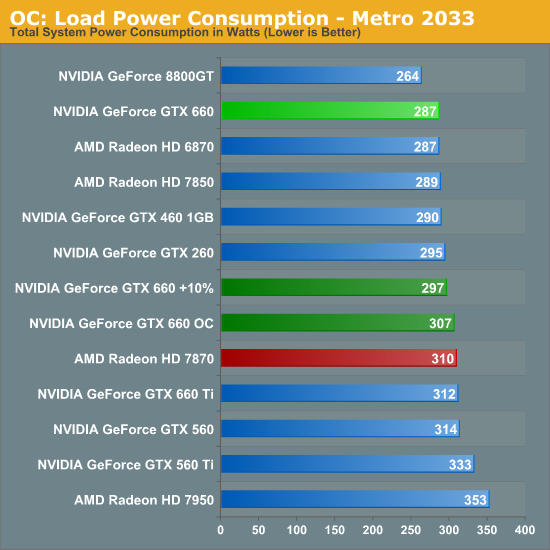
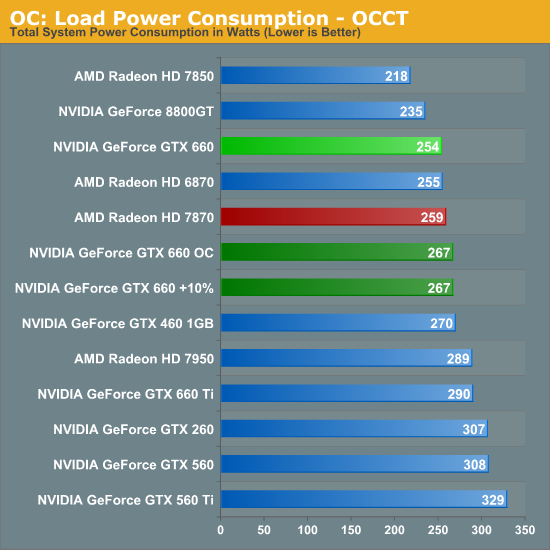
With a 110% power target we should be seeing an 11W-14W increase in power consumption, which is indeed roughly what we’re seeing at the wall after accounting for PSU inefficiencies. In Metro this is just enough of a difference to erase most of the GTX 660’s power consumption advantage over the GTX 660 Ti, though the GTX 660 still draws marginally less power than the stock 7870. Meanwhile under OCCT the GTX 660 now draws more power than the 7870, but still is still drawing over 20W less than the stock GTX 660 Ti.
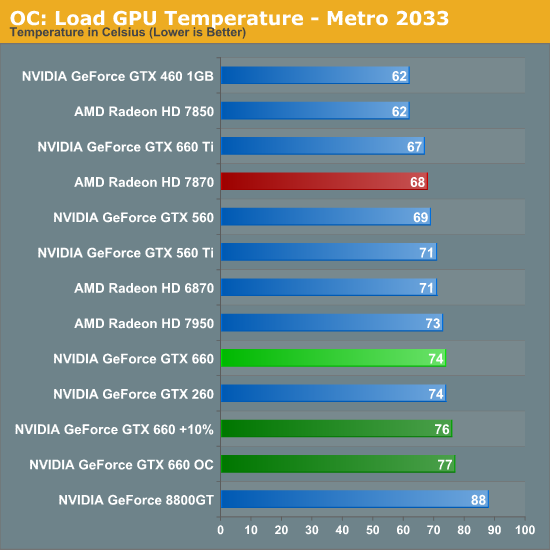
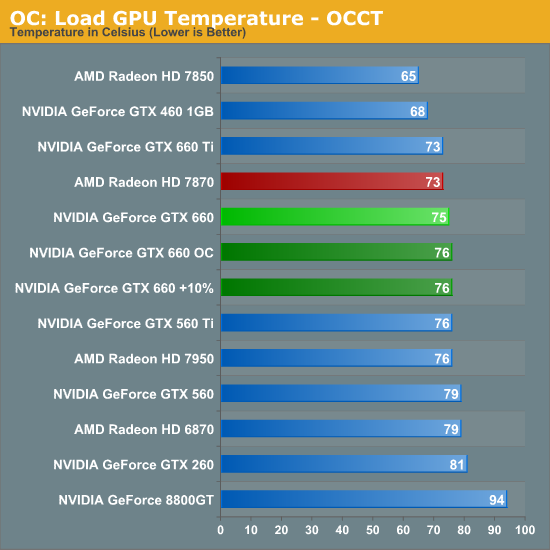
Our increased power consumption pushes temperatures up by another 2-3C. This is nothing a blower can’t handle, let alone an open-air cooler.
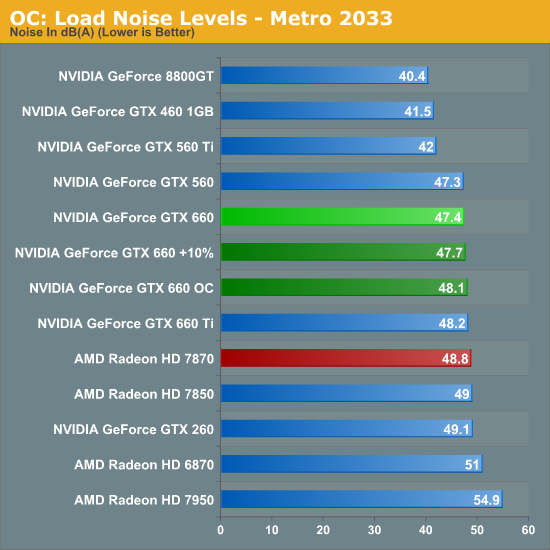
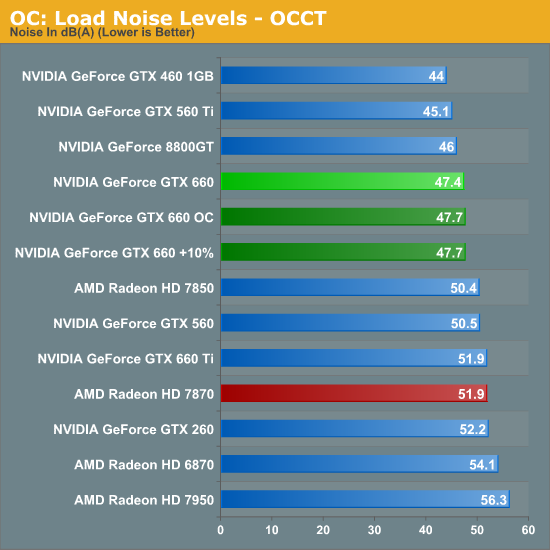
Interestingly enough, despite the increase in power consumption and temperatures, overclocking has almost no impact on noise. In the worst case scenario our GTX 660’s increased its fan speed by all of 2%, which increases noise by less than 1dB. As a result the amount of noise generated by the overclocked GTX 660 is practically identical to that generated by the stock GTX 660, and still below the reference 7870.










147 Comments
View All Comments
Margalus - Thursday, September 13, 2012 - link
you say the stock 660 looks bad when compared to an overclocked 7870? what a shock that is!I guess it's always fair to say an nvidia card is bad when comparing the stock reference nv card to overclocked versions of it's nearest amd competitor..
Patflute - Friday, September 14, 2012 - link
Be fair and over clock both...poohbear - Thursday, September 13, 2012 - link
well after reading this im still have with my Gigabyte OC gtx 670 i got 2 months ago for $388. I will NOT be upgrading for 3 years & im confident my GTX 670 will still be in the upper segment in 3 years (like my 5870 that i upgraded from), so @ $130/yr its a great deal.poohbear - Thursday, September 13, 2012 - link
erm, i meant i'm still happy*. sucks that u can't edit on these comments.:pKineticHummus - Friday, September 14, 2012 - link
i had no idea what you meant with your "im still happy" edit until I went back to read your original statement again. somehow I mentally replaced the "have" with "happy" lol. reading fail for me...distinctively - Thursday, September 13, 2012 - link
Looks like the 660 is getting a nasty little spanking from the 7870 when you look around at all the reviews. The GK 106 appears to loose in just about every metric compared to Pitcairn.Locateneil - Thursday, September 13, 2012 - link
I just built a PC with 3770K and Asus Z77-v Pro, I was think to buy GTX 670 for my system but now I am now confused if it is better to go with 2 GTX 660 in SLI?Ryan Smith - Friday, September 14, 2012 - link
Our advice has always been to prefer a single more powerful card over a pair of weaker cards in SLI. SLI is a great mechanism to extend performance beyond what a single card can provide, but its inconsistent performance and inherent drawbacks (need for SLI profiles and microstuttering) means that it's not a good solution for when you can have a single, more powerful GPU.knghtwhosaysni - Thursday, September 13, 2012 - link
Do you guys think you could show frametimes like techreport does in your reviews? It can show some deficiencies in rendering that average FPS doesn't, like with Crysis 2 http://techreport.com/review/23527/nvidia-geforce-...It's nice that techreport does it, but I think Anandtech is the first stop for a lot of people who are looking for benchmarks, and I think if you guys showed this data in your own reviews then it would really push AMD and Nvidia to iron out their latency spike problems.
Ryan Smith - Friday, September 14, 2012 - link
We get asked this a lot. I really like Scott's methodology there, so if we were to do this I'd want to do more than just copy him by finding some way to do better than him (which is no easy task).To that end I find FRAPS to be at a higher level than I'd like. It's measuring when frames are handed off to the GPU rather than when the GPU actually finishes the frame. These times are strongly correlated, but I'd rather have more definitive low-level data from the GPU itself. If we could pull that off then frametimes are definitely something we'd look in to.